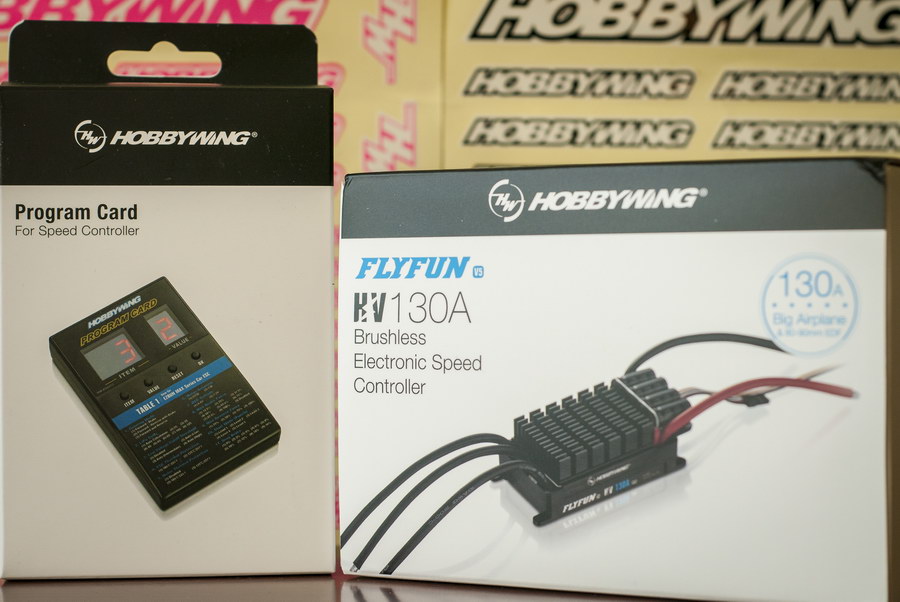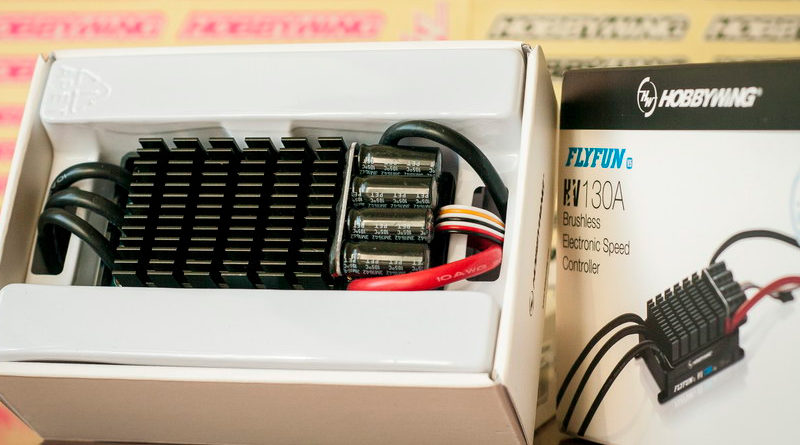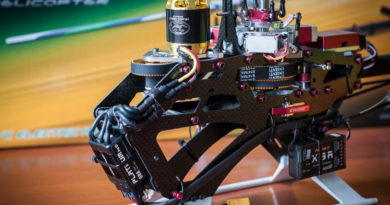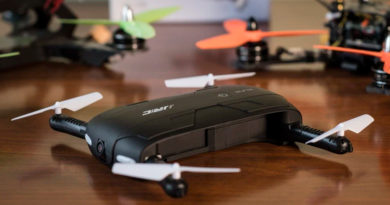HobbyWing FlyFUN V5 130A OPTO — the newest series of ESCs on the market

Another very new and one of the best series of hobby product for your powerplant on the market from the leading eadge manufacturer HobbyWing — FlyFUN V5 series ESC. And again, we are not afraid of such declaration — if you need the best possible solution to drive your large scale EDF or a regular propeller plane (or even car or a boat) but at the same time a very affordable solution — think of the HobbyWing newest FlyFUN ESCs lineup!

We’ve already tested and reviewed other HobbyWing products for FPV and R|C heli applications:
and found that those products are excellent performers in terms of power delivery and math logics inside. Additionally, latest HobbyWing products have the leading price|quality|performance ratio on the market. Best heli and fpv racing copter pilots around the world are choosing this brand nowadays for competitions as well as for general hobby use.
Today we have one of the first FlyFUN 130A HV OPTO electronic speed controllers available on the market which we would like to test and review. We would also cover HobbyWing LED program box in this review — as the most convenient and inexpensive device to program our ESC in the field.

It is worth to mention now that FlyFUN V5 series consists of the following speed controllers:
- FlyFUN V5 60A
- FLyFUN V5 80A
- FlyFUN V5 120A
- FlyFUN V5 120A OPTO (No BEC)
- FlyFUN V5 HV 130A OPTO (No BEC)
- FLyFUN V5 HV 160A OPTO (No BEC)
All these models share the same technologies, features and settings which means that all infromation that we would provide and review here would not only apply to 130A HV OPTO ESC but to all other models of the same series.
You can buy HobbyWing FlyFUN 130A HV OPTO V5 here
HobbyWing FlyFUN 130A HV OPTO technical specifications:
- Product Name: FlyFUN 130A HV OPTO V5
- Type: for Brushless, high-voltage
- Cont./Peak Current: 130A / 160A
- Input Voltage: 6 — 14S LiPo
- BEC Output: NO
- Wires & Connectors: Input Wires: Red-10AWG-150mm*1 / Black-10AWG-150mm*1 Output Wires Black-10AWG-150mm*3
- Input|Output Connecotors: NO
- ESC Programing via: LED Program Box, transmitter
- Firmware Upgrade: NO
- Size: 110.0 x 50.3 x 33.2mm
- Weight: 221.5g
- Applications: propeller aircraft, EDF (+ cars, boats)
Let’s take a look at the declared features:
- DEO Technology / Active Freewheeling: The DEO technology (Driving Efficiency Optimization) implemented in the ESC has multiple advantages: Faster and smoother throttle response — better stability and flexibility during flight. Higher driving efficiency — longer flight time. Lower ESC temperature — more reliable operation.
- Soft Start-ups & Reverse Brake: New soft start-up modes are applicable to regular propeller aircraft and EDF aircraft with different sizes. With Reverse Brake mode enabled when landing — distance can be significantly shortened (FLYFUN 130A/160A-HV-OPTO-V5 doesn’t have this function). Normal Brake Mode, Proportional Brake mode, and Brake Disabled mode are also available; the brake amount is adjustable in normal brake mode while in proportional brake mode the brake force will be automatically calculated on the basis of the position of the radio throttle stick.
- High-power BEC (only for the models with BEC): High-power switch-mode BEC with continuous/peak current of 8A/20A and voltage adjustable among 5.2V, 6.0V and 7.4V allows users to have more electronic devices with higher power like servo, flight controller and on-board light on their aircraft.
- Multiple Protections: Multiple protection features include start-up, over-current, ESC thermal, capacitor thermal, overload, throttle signal loss (or Fail Safe), and abnormal input voltage. All of that effectively prolongues life of the ESC.
- New Design & Great performance: New design brings exclusive look and good heat-dissipating performance. High quality components, high-performance 32-bit microprocessor, and the PCB with extremely low impedance guarantee great current endurance, excellent performance and high reliability.
- Multiple Programmable Parameters: Multiple programmable parameters for setups of different fixed-wing aircraft are adjustable via transmitter or Hobbywing LED program box.
All features look very familiar to what we’ve already seen in the Platinum PRO V4 for R|C heli series. And taking into consideration the fact that Platinum PRO V4 performs perfectly — we expect that FlyFUN V5 would not let us down on large scale planes and would deliver the same consistent performance. We would check it a bit later.

As it is clear from the specifications, in contrary to Platinum PRO V4 which can accept various types of programming devices, FlyFUN V5 ESCs can be programmed in 2 ways only — via transmitter or via LED program box. Therefore, in order to have the most convenient way of setting it up in the field — we would recommend to grab one of LED program boxes that HobbyWing sells along with their ESCs. Let’s look now at the program box itself:
Specifications:
- Size: 88x58x14mm (LxWxH)
- Weight: 40g
- Input Voltage: 4.8 — 8.4V(a separate battery is needed for powering this program box when ESC has no built-in external BEC or special programming port)
Features:
- This LED program box is for programming HobbyWing brushless ESCs. Its friendly interface makes ESC programming easy and quick.
- It’s compact, portable and very applicable for field use. It works with the following HobbyWing products: 1.Platinum V1/V2 series & FlyFun V5 series of brushless aircraft ESCs. 2.XeRun series (most), EzRun series & QuicRun series of brushless car ESCs. 3.SeaKing series of brushless boat ESCs.
Concerning the fact that our 130A ESC has the special programming port — we only have to connect LED program box to ESC with the dedicated cable and power everything on by connecting main battery to ESC. That’s it.
LED program box manual can be found here

In the box:
First of all the box has counterfeit item protection special sticker which is very good to have nowadays when there are many fake items being sold by some popular but not very responsible shops.
ESC is neatly packed inside and there is nothing to worry about during the transporation. Speed controller and English user manual are the only contents of the box. This ESC comes with no connectors on both sides — neither to motor nor to battery. It is left for a user to decide which type of connectors would be used.
LED program box comes in a very similar package along with English user manual, 1 servo-type connection cable, 1 extra sticker for Platinum V1&V2 settings, 1 more sticker for FlyFUN V5 settings and already applied sticker with all settings for the rest of the compatible ESC types.

Materials, build and design:
Just great! 130A HV V5 ESC has the excellent build and finish quality. All wires are carefully packed into the case which is made of plastic + aluminum. Plastic is perfectly moulded, has plenty of neat labels and has special mounting holes to aid in aircraft build. Huge aluminum radiator at top would help to effectively dispose the excess of heat. 4 large capacitors are holding tight and rest on the special podium. It would not let capacitors legs to bend.
This ESC weights 221g and has a dimensions of 110×50.3×33.2 — not very small but at the same time it shares the common physical parameters with the most 130A ESCs for planes.

LED program box has full-plastic body with couple of LED windows covered with protective sticker and a button operation sticker with all parameters listed there. It makes such programming devices very intuitive and easy to use. Much easier comparing to special PC software or other PC-based devices. The build quality is more than expected for such kind of devices. Nothing to worry about here as well.
Initially, LED box has other types of ESCs sticker table attached to the front and back of the case. Table 1 goes to the front and Table 2 goes to the back. In order to use it with FlyFUN V5 — we have to remove initial blue Table 1 sticker from the front and apply provided yellow Table 1 FlyFUN V5 sticker instead. The back sticker is not applicable in case of using FlyFUN V5.

Connections:
Nothing much to explain here. 130A ESC has the following connection cables:
- Main battery leads (to 6-14S LiPO), 10AWG wires
- Main motor leads, 10AWG wires
- 1 servo-type longer cable which splits to: 3-wire (red, black, white) servo-type connection to radio receiver & 1-wire (yellow) servo-type connection of reverse brake function, goes to radio receiver extra port for reverse braking on|off function control via separate receiver channel.
- 1 servo-type short cable — this is dedicated programming line to connect to LED program box.
LED Program box has servo-type port where dedicated programming port wire from ESC should be connect to.
Two important fact to remember when using LED program box and tuning our ESC:
- LED program box should be connected PRIOR to powering ESC on
- New setting would apply ONLY after ESC powered OFF and ON again.
So, don’t forget that whatever parameter you set in the ESC — it would only start to act as desired after the next power cycle.
FlyFUN V5 ESC parameters:
Suppose that you have connected LED box to the ESC, applied FlyFUN V5 sticker to the LED box, powered it on and ready for tuning…
On the LED box you have 4 buttons: Item (scrolls the parameter), Value (chages the parameter value), Reset (resets the value to default), Ok (saves the new value). It is very intuitive to operate.
FlyFUN V5 ESC series have the following tunable parameters:

- Brake Type:
- Normal Brake: brake function will be activated when you move the throttle stick to the bottom position. In this mode, the brake amount equals to the brake force you’ve preset.
- Proportional Brake: throttle range of 20% to 100% (on the transmitter) will correspond to the ESC throttle output of 0% to 100% while the throttle range of 20% to 0% (on the transmitter) will correspond to the brake force of 0 to 100%.
- Reverse Brake: Reverse Brake signal wire (its signal range must be the same as the throttle range) must to be plugged into any vacant channel on the receiver, and you can control the motor direction via that channel. The channel range of 0-50% is the default motor direction, the channel range of 50% to 100% will cause the motor to spin counterclockwise. The channel stick should be within the channel range of 0-50% (0 would be better) when the first time you power on the ESC. After the Reverse function has been activated the motor will stop first and then spin in the reversed direction and then increase to the speed corresponding to the throttle input. Either signal loss, no matter reverse brake signal loss or throttle signal loss during the flight, can cause the throttle signal loss protection to be activated (not applicable to 130A HV OPTO ESC)
- Brake Force: This item is adjustable from level 1 to level 7. The higher the level, the stronger the braking effect. It’s only effect in the “Normal brake” mode.
- Voltage Cutoff Type:
- Soft Cutoff: ESC will gradually reduce the output to 50% of the full power in 3 seconds after the low-voltage cutoff protection is activated.
- Hard Cutoff: ESC will immediately cut off the output when the low-voltage cutoff protection is activated.
- LiPo Cells: The ESC will automatically calculate the number of LiPo cells you have plugged in as per the “3.7V/Cell” rule if “Auto Calc.” is selected, or you can set this item manually.
- Cutoff Voltage: This item is adjustable from 2.8V to 3.8V (they are the cutoff voltages for one cell), it’s 3.0V by default; or you can disable it if necessary.
- BEC Voltage: This item is adjustable among 5.2V, 6.0V and 7.4V (not applicable to OPTO ESCs)
- Start-up Mode:
- Normal Start-up: motor will immediately start spinning and then quickly reach the corresponding speed when you move the throttle stick from bottom to top position.
- Soft Start-up: motor will slowly start spinning and then quickly reach to the corresponding speed when you move the throttle stick from bottom position to top position.
- Very Soft Start-up: motor will slowly (slower than in “Soft Start-up Mode”) start spinning and then quickly reach to the corresponding speed when you move the throttle stick from bottom position to top position.
- We recommend selecting the “Soft Start-up” or “Very Soft Start-up” mode when you are flying an airplane with a big-sized ducted fan. Please ensure to select the “Very Soft Start-up” mode if the diameter of the ducted fan on your airplane is over 90mm.
- Timing: This item is adjustable from 0 degree to 30 degrees, and it is 15 degrees by default.
- Motor Rotation: This item allows you to change the direction of your motor rotation between CW and CCW, CW by default.
- Freewheeling: This item is adjustable between “Enabled” and “Disabled” and is enabled by default. While enabled, you can have better throttle linearity or smoother throttle response.
The default parameters are marked with «*» in the app and can be found in the ESC manual.
So, not many parameters to tune. Took me about 3 minutes to set everything as desired. One more thing that you would have to do prior to setting everything up — is to calibrate your ESC with your radio and receiver. This is done as usually — connect everything together (motor to ESC, ESC to receiver), Throttle channel all the way up on the radio, power ON receiver with ESC connected to THR channel and you should hear a series of beeps that correspond to entering programming mode. Throttle stick all the way down and you would hear the min THR and confirmation beeps. Power everything OFF and you’re done.

ESC protection technologies:
In order to make sure that everything would go butter-smooth in flight, HobbyWing have added several protection layers to FlyFUN V5 series ESCs:
- Start-up Protection: ESC will monitor the motor speed during the start-up process. When the speed stops increasing or the speed increase is not stable the ESC will take it as a start-up failure. At that time, if the throttle amount is less than 15%, the ESC will automatically try to restart up; if it is larger than 20%, you need to move the throttle stick to back the bottom position and then restart up the ESC. (Possible causes of this problem: poor connection/ disconnection between the ESC and motor wires, propellers are blocked, etc.)
- ESC Thermal Protection: motor will “stutter” when the ESC temperature goes above 110℃ to indicate that the ESC thermal protection is activated. If lower down the throttle input to below 60% at this moment the “stuttering” will disappear and the ESC will output the corresponding power. The motor will start to “stutter” again if the throttle input exceeds 60%. If this happens — disconnect the battery first and then reconnect it to the ESC after the ESC cools down (the ESC temperature cannot exceed 70℃, otherwise it cannot be started), it will resume the normal operation.
- Throttle Signal Loss Protection: when ESC detects loss of signal for over 0.25 second it will cut off the output immediately to avoid any loss which may be caused by the continuous high-speed rotation of propellers or rotor blades. The ESC will resume the corresponding output after normal signals are received.
- Overload Protection: ESC will cut off power/output or automatically restart itself when the load suddenly increases to a very high value. (Possible cause is that propellers are blocked or the motor and the ESC are out of sync.)
- Over-current Protection: ESC will cut off output power immediately when the peak current exceeds the regulated value and then would resume the output. If the current continues to go above the regulated value — the output will be completely cut off. This protection may be activated by the short-circuit in motor or something else.
Huh… Again, is with the FlyFUN V5 series — I feel myself well protected and comfortable. At least — it is a fool-proof device and I hope that it would not burn right away if I’d suddenly forget about proper safety rules
ESC performance:
Test setup:
Enjoy FAI F3A pilotage (P and F17) large-scale propeller plane.

This model was specially designed and constantly upgraded by Belorus manufacturer Enjoy to comply with FAI rules and flight manuevers. This is sport model, not a toy!
Wing span: 1890mm, length: 1900mm, weight: 1900g (10S LiPO, 4,5Ah)
And it is equipped with the Plettenberg Advance 30-10 motor: weight: 590g, 8-10S LiPO, 20 magnets, propeller: 22 x 12″
ESC was situated inside the aircraft which took about 15 minutes. 4mm bullet connectors were used to connect motor and ESC. FlyFUN ESC took a place in the model instead of the professional Jeti Spin 90A OPTO ESC which was a fraction smaller and had a less weight. But again — Jeti is only 90A and our new FlyFUN is capable of 130A with bursts to 160A current.

This model with such motor was specially chosen for this test. F3A models are usually prepared with the best possible electonic components and should perform with 100% reliability of each element to comply with the flying manuevers. Plettenberg motor is unique — is has a outrunner features but really built as inrunner inside. Motor stator is tied to the outer casing and inner shaft that has a shape of a fat barrel rotates inside and driven by 20 powerful magnets. This motor has all the tuning parameters of outrunners and all the advantages of inrunners druing the work — very linear power output at all stick inputs which is necesssary to fly in F3A class.
Preflight checks:
Right after we have placed FlyFUN V5 into the plane — the next thing we’ve done was to check the maximum power, current and minumum battery voltage levels with watt-meter. It would be a pity if the new speed controller won’t carry out our tests and burn the motor or disappear in flames…

But the wattmeter tells us that we are far from loading this ESC to 100% and showed pretty expected figures. Our setup was eating as much as 78A continuously at max throttle input with 10S 4,5Ah 25C battery. Max current might jump to ~100A druing the flight hardest manuevers but still won’t hit the upper capability of HobbyWing 130A ESC.
Due to the fact that FlyFUN 130A V5 os OPTO-type — we used external BEC to supply voltage to the rest of onboard components.

In flight:
Excellent! During all of the test flights we haven’t expereinced any problems with the plane, motor or power delivery. Throttle response had the expected linearity as we’ve got used to during our previous flights and with our previous setup. HobbyWing FlyFUN 130A OPTO V5 ESC could withstand all of F3A manuevers with ease while delivering the reliable power output at any overloads. But in addtion to that — our FlyFUN 130A ESC was surprisingly cold each time we’ve landed after ~8-10 minutes of flight session. Despite the ambient temperature reaching +28C that day — FlyFUN stayed ~41C at most. This is absolutely suprerior to our PRO-level Jeti ESC that had lots of power disposed as heat. Think that it is due to much more continuous current cabability of FlyFUN ESC and huge cooling radiator on top of that to dispose the heat.
Therefore, our conclusion would be that HobbyWing FlyFUN V5 series of ESCs is excellent product lineup for hobby and pro-level sports use. It should comply with any size and class model, thanks to the wide series lineup in terms of max current and features. And last but not the least — its price|performance|quality ratio just pushes it right to the top among all other ESCs available on the market!
We would stick to this ESC and would be using it from now on instead of our Jeti Spin 90A due to the much higher load capability of FlyFUN 130A HV OPTO…
You can buy HobbyWing FlyFUN 130A HV OPTO V5 here
















